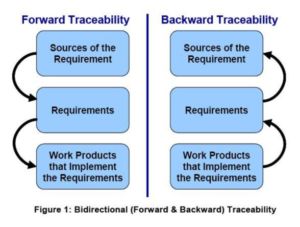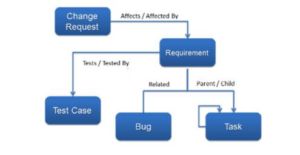Description
Traceability is one of the essential activities of good requirements management. It involves the process of documenting the life of a business concern and providing bi-directional traceability to the capability or capabilities associated with that concern. The purpose of having Traceability is to ensure that the right products are being built at each phase of the software development life cycle, to trace the progress of that development and to reduce the effort required to determine the impacts of requested changes.
Architects must be able to support to the Project teams with thought process of establishing right traceability practices from the Business requirements through to the sustained system and describe the vital role of traceability throughout the lifecycle of the ‘solution under development’. Architects should have mastery in the use of associated techniques and tools and demonstrate competence in highest priority techniques.
Overview
The IEEE Standard Glossary of Software Engineering Terminology defines traceability as “the degree to which a relationship can be established between two or more products of the development process, especially products having a predecessor-successor or master-subordinate relationship to one another.” [IEEE-610]
Traceability is used to track the relationship between each unique product-level requirement and its source. For example, a product requirement might trace from a business need, a user request, a business rule, an external interface specification, an industry standard or regulation, or to some other source. Traceability is also used to track the relationship between each unique product-level requirement and the work products to which that requirement is allocated. For example, a single product requirement might trace to one or more architectural elements, detail design elements, objects/classes, code units, tests, user documentation topics, and/or even to people or manual processes that implements that requirement.
Good traceability practices allow for bidirectional traceability, meaning that the traceability chains can be traced in both the forwards and backwards directions as illustrated below.
For example, if a Solution is being developed using the Microsoft Solution Framework model, Microsoft provides an ALM tool called ‘Microsoft Visual Studio Team Suite’ that provides a process template for the traceability as below:
Architects need this skill to ensure the ‘solution under development’ is being developed in an expected manners throughout the life cycle of the project. Through traceability, it gives a 360 view of the business requirement being realized in the solution.
One common tasks involved in this skill is identifying the right tool for managing the solution under development. The tool should be able to support establishing the bi-direction traceability between the various work-items produced during the software development life cycle (SDLC) at various stages i.e. Requirements Analysis, Design, Development, Test, Deploy, Operations.
Establishing traceability correctly gives a timely view of the current state of the ‘Solution under development’ and thereby helps Architect assess the stability of the Solution and help provide inputs to the stakeholders of the Solution in terms of triple constraints viz., Resource, Schedule, and Scope.
One of the daily activities during the SDLC is to generate a report of the forward traceability and backwards traceability of the Project. The adopted tool should support providing the report to facilitate an understanding of the current state of the Project.
Proven Practices
Architect provides a unique cross discipline view of the activities involved in the projects, across the business and the technical areas as establishing traceability requires a balanced understanding of the business domain (vision, goals, objectives, requirements) and technical underpinnings of the SDLC methodologies, processes and the various tools that support the same.
Key challenge that Architect may face in establishing this skill is the teams’ adoption as the right practice of traceability gives the accurate view of the project progress thereby exposing the Project teams’ daily accountabilities towards reaching the goal.
Engagement of an Architect for utilizing this skills requires the following:
- Clear visibility of the business problems that the Solution is expected to meet (Business vision, goals, objectives, Requirements)
- Choosing the right SDLC methodology/ process that aligns with the business and IT team
- Selecting the right ALM (Application Life Cycle Management) tool that supports the various phases prescribed by the selected methodology
- Drive the adoption of the traceability through the selected ALM tool among the project team as a daily activity throughout the SDLC
- Build traceability reports that help in providing the progress of the ‘solution under development’ towards realizing the goals
- Analyze the impact of a change
-
- All work products affected by a changed requirement
- All requirements affected by a change or defect in a work product
- Assess current status of the requirements and the project
- Identify missing requirements
- Identify gold plating
Sub-Capabilities
Traceabilty Management
The processes and techniques to describe and follow the life of an artifact from its origins, through its development and specification, to its subsequent deployment and use, and through periods of ongoing refinement and iterations.
The Software Engineering Institute (SEI) Capability Maturity Model Integration® (CMMI®) states that the purpose of the process area in “Requirements Management is to manage the requirements of the project’s product and product components and to identify inconsistencies between those requirements and the project’s plans and work products.” [SEI-00]. One of the specific practices under the Requirements Management process area is to “Maintain Bidirectional Traceability of Requirements.” [SEI-00].
| Iasa Certification Level | Learning Objective |
|---|---|
| CITA- Foundation |
|
| CITA – Associate |
|
| CITA – Specialist |
|
| CITA – Professional |
|
Bi-Directional Traceability
Documentation, visualization and description techniques that help establishing the traceability chains that can be traced in both forward and backwards directions as illustrated in the figure titled ‘Bi-Directional (Forward & Backwards) Traceability’..
| Iasa Certification Level | Learning Objective |
|---|---|
| CITA- Foundation |
|
| CITA – Associate |
|
| CITA – Specialist |
|
| CITA – Professional |
|
Verification and Validation
The process of checking that a product, service, or system meets specifications and that it fulfills its intended purpose through the adoption of right Traceability Techniques. Forward Traceability ensures proper direction of the evolving product (that we are building the right product) and indicates the completeness of the subsequent implementation.
| Iasa Certification Level | Learning Objective |
|---|---|
| CITA- Foundation |
|
| CITA – Associate |
|
| CITA – Specialist |
|
| CITA – Professional |
|
Reference Resources
IEEE-610
IEEE Standards Software Engineering, IEEE Standard Glossary of Software Engineering Terminology, IEEE Std. 610-1990, The Institute of Electrical and Electronics Engineers, 1999, ISBN 0-7381-1559-2.
SEI-00
CMMISM for Systems Engineering/Software Engineering, Version 1.02 (CMMI-SW/SW, V 1.02); CMMI Staged Representation, CMU/SEI-2000-TR-018, ESC-TR2000-018; Continuous Representation, CMU/SEI-2000-TR-019, ESC-TR-2000-019; Product Development Team; Software Engineering Institute; November 2000.
Articles
Requirements Traceability http://en.wikipedia.org/wiki/Requirements_traceability
Application Lifecycle Management http://en.wikipedia.org/wiki/Application_lifecycle_management
Ivar Jacobson international http://www.ivarjacobson.com/resources/resources/white_paper/
Cunningham & Cunningham Inc. http://www.c2.com/cgi/wiki?UserStoryAndUseCaseComparison
Ivar Jacobson’s Blog: http://blog.ivarjacobson.com/ivarblog/
A Guide to the Business Analysis Body of Knowledge (BABOK Guide) http://www.iiba.org/BABOK-Guide.aspx
IIBA Online Library http://www.iiba.org/Learning-Development/Online-Library.aspx
Microsoft Solution Framework http://en.wikipedia.org/wiki/Microsoft_Solutions_Framework
TRAINING:
IIBA Business Analysis Training http://www.iiba.org/Learning-Development/Endorsed-Education-Provider-Training.aspx
CERTIFICATIONS:
International Institute of Business Analysis’ (IIBA) Certification of Competency in Business Analysis (CCBA)
International Institute of Business Analysis’ (IIBA) Certified Business Analysis Professional (CBAP) certification
MCSD: Application Lifecycle Management https://www.microsoft.com/learning/en-us/mcsd-application-lifecycle-management.aspx
Author
 Vidyasagar Chitchula
Vidyasagar Chitchula
IT Architect – Microsoft Global Services (India)
Vidyasagar is a certified CITA-P, TM Forum BDM and TOGAF Practitioner. He has led architecturally significant enterprise engagements for Global Top 500 Companies.
Vidyasagar has been an architect working for Microsoft Services Global Delivery since 2008. He has 13+ years of total experience in the Software Industry. His experiences have been in product and project development in architecture, design, and development of distributed applications in the Microsoft technology space in the domains viz., CRM, Agro ERP, Medical Transcription, Academia, Hospital Information Systems and Telecommunications. Prior to Microsoft, he worked as a Technical Architect for Pivotal CRM, a CDC Software Company with revenues of about USD 500 million.
On the business front, Vidyasagar is a seasoned professional in CRM space by way of working on 3 CRM products and multiple domains viz., Telecommunications, BFSI, Utilities, Professional Services and Health Care. He possesses great product and services knowledge in CRM space with 11 years of experience in that area alone. He has worked with diversified clientele in his 11 years of CRM experience that include fortune 500 Organizations in Telecommunications, BFSI, BPO and Professional Services organizations across the world, USA, LATAM, Singapore, India, Europe, MEA. His special interests include building solutions in the telecommunications domain.
Prior to his IT experience, he had another 2 years of experience as a teaching assistant in academia while pursuing his Masters in Software Systems.









